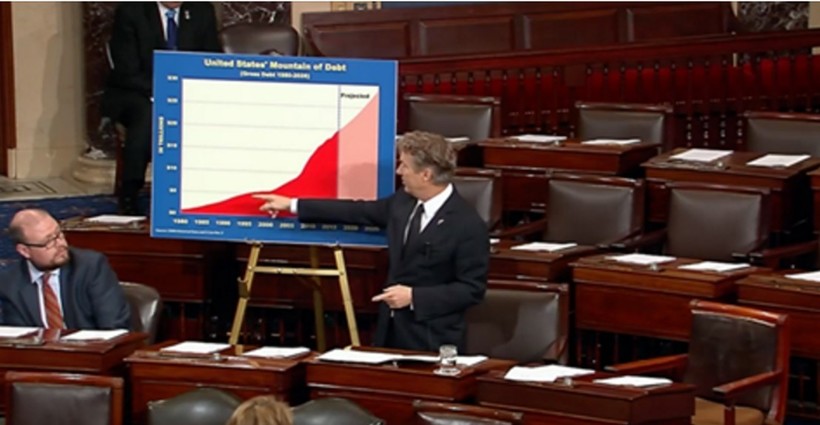Recently a friend posted a video of Rand Paul lamenting over the recent GOP budget that adds $9.7 trillion of debt over the next 10 years. He was perplexed how conservatives, who have amassed total power, would align to such a shortfall in accountability. The reason is actually quite simple. The GOP campaigns on voodoo math and once ideas are vetted with actual costs Republicans grossly under qualify the impacts. This is the primary reason I didn’t vote for Governor Romney. His claims of reducing deficits were based on closing deductions he refused to identify and several watchdog groups gave higher marks to President Obama’s budget.
Over the past 40 years Republicans have proven themselves inept at managing our nation’s budget. The only two presidents during this period that watched annual deficits decline over their administrations were Clinton and Obama. In fact, the largest mishandling of both discretionary and mandatory expenditures happened the last time Republicans had complete control of government. In the early 2000’s the GOP rammed through an unfunded trillion dollar prescription drug plan, two expensive wars, and simultaneously passed two of the largest tax cuts in our nation’s history. This complete assault on basic math led to trillion dollar deficits once coupled with the economic collapse in 2007-2008.
Fast forward to 2016 and we are witnessing a similar pattern by controlling Republicans. The Committee for a Responsible Federal Budget has already warned the dismantling of Obamacare will result in $350 billion of additional debt due to the loss of mandates and tax penalties. Economists are also predicting the expansion of Baby Boomers on Social Security and Medicare will add hundreds of billions of dollars to our annual deficit unless mandatory expenditures are restructured. Republican promised tax cuts will also drive gaps in income which will be passed to our National Debt as well as increases in military and infrastructure expenditures proposed by President-Elect Trump. In fact, just looking at basic assumptions in Rand Paul’s presentation paint a very rosy picture of $9.7 additional debt including claims of aggressive GDP growth rates and the impact of tax cut reinvestment.
One of my favorite moments in the 2016 campaign was watching Chris Wallace of Fox News challenge Donald Trump on his budget assumptions during a debate. Donald Trump claimed we could save $300 billion in Medicare prescription costs when in fact our total spend is $78 billion. Trump also claimed he was going to cut $544 billion in government expenditures by gutting departments like the EPA and Education which Wallace called out:
“Mr. Trump, your numbers don’t add up…The Education Department, you talk about cutting, the total budget for the Education Department is $78 billion. And that includes Pell grants for low-income students and aid to states for special education. I assume you wouldn’t cut those things. The entire budget for the EPA, the Environmental Protection Agency, $8 billion.”
Donald Trump has backed up his intent to cripple these two departments given his recent cabinet nominees, but as Wallace pointed out, the math still doesn’t work. In addition Trump has promised a tax cut which economists estimate will add $2.6 to $3.9 trillion to the federal debt over the next decade, and infrastructure investment adding $1 trillion over the same period.
They are now asking math questions at the #GOPDebate which means there is a very long line at the restroom.
— Matty J (@GuyToYourLeft) March 4, 2016
Most Americans do not understand the impact Social Security, Medicare, and military spending has on our budget. Any proposal that does not restructure these three pillars is political hogwash. Dismantling Obamacare, the EPA, or the Education Department makes for great partisan theater but is negligible when measuring budgetary impact. Military spending makes up almost 20% of our total budget with projects like the prized $500-billion-over-10-years-F-35 fighter which can’t fly in the rain and is outmaneuvered by the older F-16. Such expensive weapons systems and Trump’s promise of expanding military will negate any gains in government cuts and will drive an additional $500 billion in spending, according to the Congressional Budget Office.
Over the next four years annual deficits will again rise to over a trillion dollars given current projections and Republican priorities. Strong economic growth cannot curb the vast mismanaging of expenditures and the only way to actually reduce the deficit is to restructure senior entitlements or cut military spending. This short term pain of Republicans incompetence will eventually yield to exposing the fraudulent practices of GOP budgetary rhetoric. This will also provide a window for Democrats to take back some balance in our Federal government. Republicans might hammer the “tax and spend” talking point, but Democrats contend their proposals are rational and transparent and have a track record of producing a balanced budget.
